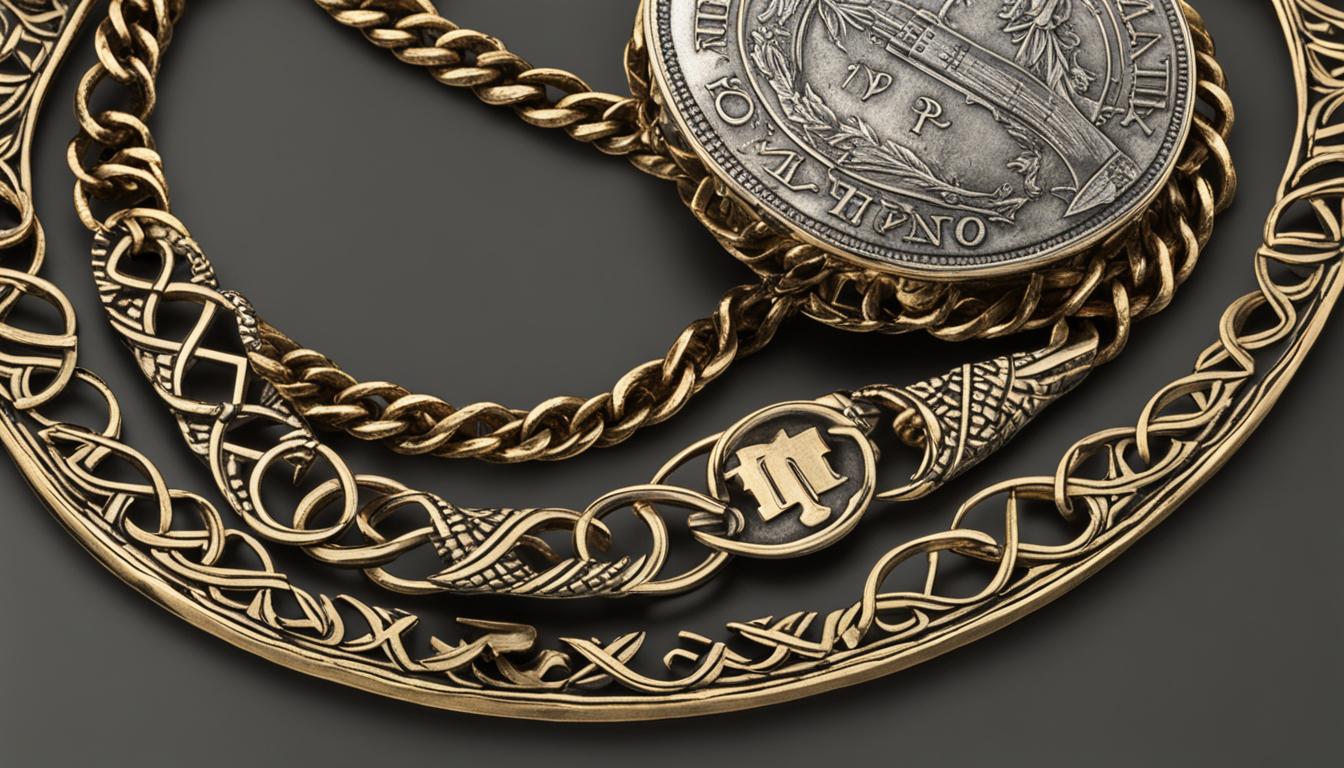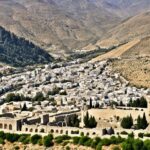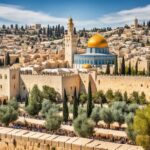In the Bible, “Mizpah” is a significant term that carries historical, cultural, and theological significance. It refers to a couple of cities mentioned in the Scriptures, including Mizpah of Gilead and Mizpah in Benjamin. The name “Mizpah” itself means “watchtower” or “lookout,” symbolizing God’s watchful presence and protection.
One of the notable events associated with Mizpah is found in Genesis 31:45–49, where Jacob and Laban made a covenant at Mizpah of Gilead. They erected a heap of stones as a marker and named the place Mizpah, signifying their agreement. This covenant marked a boundary between their lands and emphasized the importance of God’s watchfulness over their relationship.
Throughout biblical history, Mizpah served as a gathering place for the Israelites, where important decisions were made, conflicts were resolved, and divine guidance was sought. The geographical locations of Mizpah, both in Gilead and Benjamin, played a significant role in shaping the events that unfolded there.
Additionally, Mizpah has left an enduring legacy beyond the biblical narrative. The concept of Mizpah has been embraced as a symbol of emotional bonds between people who are separated, either physically or by death. Mizpah jewelry, such as the Mizpah necklace, often featuring a split design and the inscription “The LORD watch between me and thee,” is worn as a token of lasting connection.
Key Takeaways:
- Mizpah in the Bible refers to a couple of cities mentioned in the Scriptures, such as Mizpah of Gilead and Mizpah in Benjamin.
- The term “Mizpah” means “watchtower” or “lookout,” symbolizing God’s watchful presence and protection.
- Jacob and Laban made a covenant at Mizpah of Gilead, marking a boundary between their lands and invoking God’s watchfulness.
- Mizpah served as a gathering place for the Israelites to address important issues, make decisions, and seek divine guidance.
- Mizpah has an enduring legacy, and Mizpah jewelry, like the Mizpah necklace, represents emotional bonds and lasting connections.
Historical Significance of Mizpah
Mizpah holds a significant place in history, with biblical events that showcase its importance. One such event is the covenant made between Jacob and Laban at Mizpah. They established a boundary between their lands and marked the agreement with a pile of rocks, naming it Mizpah. This event signifies the historical significance of Mizpah as a place of negotiation and agreements.
Another notable event that took place at Mizpah was when Jephthah made a vow to the Lord before going to war against the Ammonites. This displays Mizpah’s role as a gathering place for making solemn promises and seeking divine intervention.
Furthermore, Mizpah was where Samuel erected the Ebenezer stone to commemorate a victory over the Philistines. This event highlights Mizpah’s historical significance as a site of remembrance and celebration of God’s faithfulness.
Overall, Mizpah’s historical significance lies in its association with significant biblical events, making it a place of historical and cultural importance.
Geographical Location of Mizpah
Mizpah, a significant location mentioned in the Bible, is found in various geographical areas. One Mizpah can be located in Gilead, a mountainous region situated to the east of the Jordan River. This Mizpah holds great historical importance as it is the place where Jacob and Laban forged their covenant, marking their boundaries. Another Mizpah is situated in Benjamin, near Jerusalem. It served as a gathering place for the Israelites, specifically in addressing the unfortunate events surrounding the Levite’s concubine. The geographical locations of Mizpah played pivotal roles in the events and narratives that unfolded in these regions.
Significance of Locations
The presence of Mizpah in Gilead and Benjamin highlights the broader picture of biblical narratives and the cultural contexts in which they unfold. The mountainous region of Gilead in particular symbolizes a sense of elevation and spiritual connection, while Benjamin’s proximity to Jerusalem establishes its significance as a hub for religious gatherings and civic dealings. These locations showcase the diverse landscapes and regions where Mizpah played a vital role.
Archaeological Discoveries in Mizpah
Mizpah has undergone extensive archaeological excavations, unearthing numerous intriguing artifacts and structures that provide valuable insights into the ancient history of this site. These archaeological discoveries have shed light on the lives and customs of the people who inhabited Mizpah during biblical times, enriching our understanding of its historical and cultural significance.
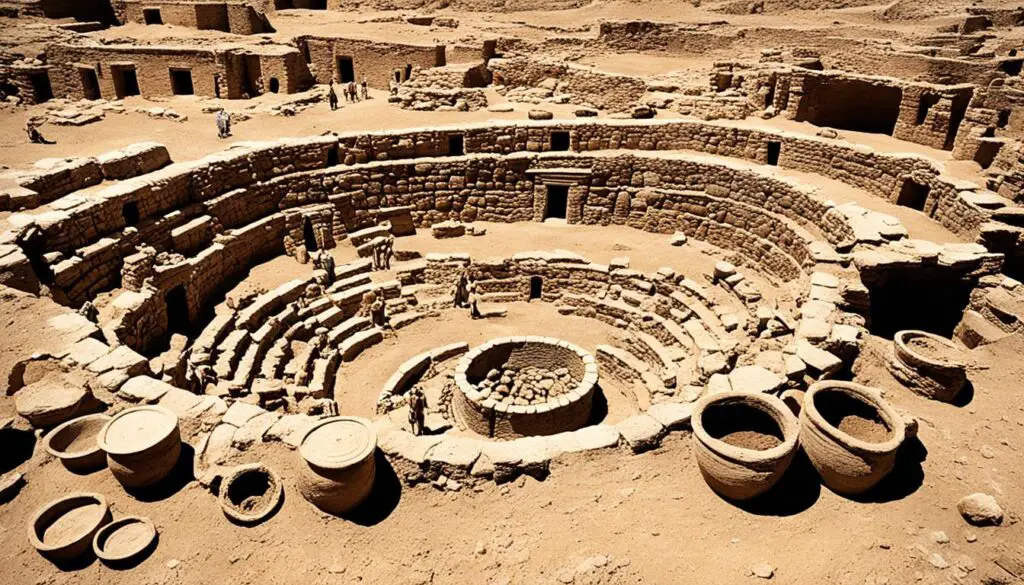
Excavations at Mizpah have revealed the presence of ancient buildings, including dwellings and public structures, which offer a glimpse into the architectural practices of the time. The discovery of pottery fragments and other artifacts provides clues about the daily life, craftsmanship, and artistic expressions of the ancient Mizpah inhabitants.
The meticulous excavation process has uncovered a variety of objects, such as pottery vessels, jewelry, tools, and religious artifacts. These findings serve as tangible links to a bygone era, offering valuable evidence of the material culture and social practices of the people who once called Mizpah their home.
Significance of Archaeological Discoveries
The archaeological discoveries at Mizpah contribute to our understanding of the historical context and cultural dynamics of this biblical site.
By examining the artifacts and structures that have been unearthed, archaeologists can piece together a more comprehensive picture of the ancient society, its economic activities, spiritual beliefs, and social interactions. These discoveries allow us to explore the ways in which the people of Mizpah lived, worked, and worshipped, providing a fascinating glimpse into their past.
In addition to providing insights into the ancient civilization of Mizpah, these archaeological findings also help corroborate the biblical narratives that mention Mizpah. They provide tangible evidence that supports the authenticity and historical accuracy of the biblical accounts, reinforcing the significance of Mizpah as a place tied to important events and figures.
Notable Archaeological Discoveries in Mizpah
| Artifact/Structure | Description | Significance |
|---|---|---|
| Pottery Fragments | Fragments of ceramic vessels, including jars, bowls, and storage containers. | Indicate domestic life, trade networks, and artistic styles of the time. |
| Jewelry | Various types of jewelry, such as necklaces, earrings, and bracelets. | Provide insights into personal adornment, fashion, and social status. |
| Ancient Buildings | Structures, including dwellings and public edifices. | Illuminate architectural practices, urban planning, and community organization. |
| Religious Artifacts | Cultic objects, such as figurines, altars, and amulets. | Offer glimpses into religious beliefs, rituals, and worship practices. |
| Tools and Implements | Ancient tools, weapons, and agricultural implements. | Provide insights into craftsmanship, technological advancements, and economic activities. |
These remarkable archaeological discoveries in Mizpah continue to contribute to the ever-expanding body of knowledge about this ancient biblical site. The ongoing excavations promise to unveil even more artifacts and structures, revealing further insights into the lives and culture of the people who once inhabited Mizpah.
Theological Themes in Mizpah
Mizpah carries a theological theme in the Bible. The name itself, which means “watchtower,” symbolizes God’s watchfulness over the covenant made between individuals. God’s presence and protection are emphasized in the story of Mizpah, where Laban used the word to invoke God’s watchful presence over the covenant. Mizpah serves as a reminder of God’s faithfulness and His role in ensuring the fulfillment of promises and the protection of His people.
“The LORD watch between me and thee when we are absent one from another.”
This biblical passage highlights the significance of Mizpah as a symbol of God’s watchful care and His constant presence in the lives of His people. It goes beyond mere physical separation and extends to the spiritual and emotional realm. Mizpah reminds believers that God is always aware and attentive, guarding their relationships and ensuring their well-being.
Mizpah’s theological theme resonates with individuals who seek reassurance, comfort, and a sense of security in their connections with others. It represents the belief in a Higher Power who watches over and protects the bonds of love, friendship, and commitment.
Divine Protection and Promises
God’s watchfulness, as depicted in Mizpah, reflects His role as a safeguard and a keeper of covenants. The story of Mizpah reminds believers of God’s unwavering faithfulness in upholding His promises and His commitment to their well-being. It reinforces the belief that God’s watchful presence ensures the fulfillment and protection of His people.
The Mizpah Blessing
The Mizpah blessing, often expressed through jewelry engraved with the words “The LORD watch between me and thee,” serves as a tangible reminder of God’s watchful care and His presence in relationships. Mizpah jewelry, such as pendants or rings, is worn as a symbol of the enduring bond between individuals and a constant reminder of God’s faithful watchfulness.
Applications in Daily Life
The theological theme of Mizpah extends beyond biblical narratives, resonating with individuals seeking divine guidance and protection in their relationships. Mizpah reminds believers to trust in God’s watchful presence and to nurture their connections with the knowledge that God is looking out for them.
| Mizpah as a Theological Theme | God’s Watchfulness |
|---|---|
| Symbolizes God’s watchful care over covenants | Reinforces belief in divine protection and guidance |
| Emphasizes God’s faithfulness in fulfilling promises | Serves as a reminder of God’s constant presence |
| Reflects the importance of trust in God’s providence | Encourages a deeper understanding of divine love and commitment |
Key Biblical Events at Mizpah
Mizpah, mentioned in both the book of Judges and the book of Samuel, was the stage for significant events in the Bible. It served as a gathering place where important decisions were made and where the fate of nations was determined.
Mizpah in the Book of Judges
In the book of Judges, Mizpah played a pivotal role in addressing a grave injustice. The Israelites assembled at Mizpah to confront the people of Benjamin regarding the mistreatment of the Levite’s concubine. The gathering highlighted the need for justice, accountability, and the preservation of moral values within the community.
This event underscored the importance of communal responsibility and the consequences of turning a blind eye to wrongdoing. It demonstrated the significance of Mizpah as a hub for seeking resolution and upholding righteousness.
Mizpah in the Book of Samuel
Mizpah continued to hold significance in the book of Samuel, where it was a site of national repentance and worship. Samuel, the prophet and judge, led the Israelites in a time of corporate reflection and spiritual renewal at Mizpah.
Moreover, after a decisive victory over the Philistines, Samuel erected an Ebenezer stone at Mizpah, symbolizing God’s faithfulness and the acknowledgment of divine intervention. This act represented the gratitude of the Israelites for their triumph and affirmed their commitment to the Lord.
“Then Samuel took a stone and set it up between Mizpah and Shen. He named it Ebenezer, saying, ‘Thus far the LORD has helped us.’” – 1 Samuel 7:12
These events at Mizpah during the time of Samuel offered the nation a chance for reflection, repentance, and spiritual restoration. Mizpah served as a geographical focal point for the Israelites to seek God’s guidance and intervention in their lives.
Throughout both the book of Judges and the book of Samuel, Mizpah emerges as a key location where significant biblical events unfold, shaping the narrative and offering valuable insights into the complexities of human relationships and the interaction between God and His people.

Cultural and Religious Practices at Mizpah
Mizpah was more than just a geographical location; it held significant cultural and religious importance for the Israelites. It served as a gathering place where people came together to worship, seek guidance from God, and resolve conflicts.
The events that unfolded at Mizpah reflected the ancient cultural and religious practices of the Israelites during biblical times. It was a place where important decisions were made, often involving communal participation and the seeking of divine intervention.
Mizpah’s association with the ark of the covenant and the tabernacle further enhanced its cultural and religious significance. The ark of the covenant symbolized the presence and glory of God, while the tabernacle was a sacred space for worship and sacrifice.
In this context, Mizpah became a focal point for spiritual gatherings and celebrations, where the Israelites united to honor their faith and seek divine guidance. It provided a sanctuary for the people, a place to connect with their heritage and reaffirm their commitment to God.
“And Samuel said unto all Israel, ‘If ye do return unto the LORD with all your hearts, then put away the strange gods and Ashtaroth from among you, and prepare your hearts unto the LORD, and serve him only: and he will deliver you out of the hand of the Philistines.’”
These gatherings at Mizpah often involved solemn rituals, repentance, and the offering of sacrifices. They fostered a sense of community and unity among the Israelites, reinforcing their faith and their dedication to living in accordance with God’s teachings.
Cultural and Religious Practices at Mizpah
| Practices | Meaning |
|---|---|
| Worship | Seeking divine guidance and expressing devotion to God. |
| Repentance | Acknowledging wrongdoing and seeking forgiveness from God. |
| Sacrifice | Offering of animals or other valuable items as a sign of devotion to God. |
| Community gatherings | Coming together as a community to pray, celebrate, and address important matters. |
These cultural and religious practices at Mizpah not only shaped the lives of the ancient Israelites but also left a lasting legacy. They continue to inspire individuals today, reminding us of the importance of communal worship, repentance, and seeking divine guidance in our own lives.
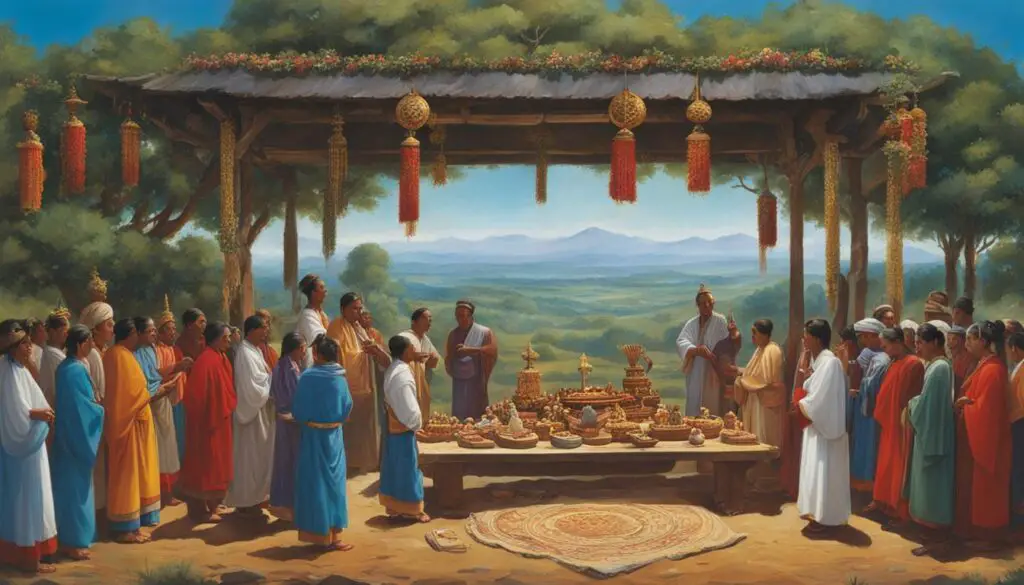
Prophetic and Eschatological Significance of Mizpah
Mizpah holds profound prophetic and eschatological significance in the Bible, going beyond its historical context. As a place where significant events took place, Mizpah foreshadowed future events and held implications for the future of Israel. Underlying these events are theological themes and eschatological implications that continue to resonate.
The name Mizpah itself, meaning “watchtower” or “lookout,” symbolizes God’s presence, protection, and faithfulness throughout history and into the future. Just as a watchtower provides a vantage point to surveil the surroundings, Mizpah signifies God’s watchful gaze over His people.
“The LORD watch between me and thee when we are absent one from another.”
This famous quote from Genesis 31:49, spoken by Laban to Jacob during their covenant agreement at Mizpah, emphasizes the prophetic significance of Mizpah. It represents not only the physical separation between Laban and Jacob but also the broader human experience of separation and longing. This verse has been etched into Mizpah jewelry, serving as a reminder of the enduring bond between individuals who are separated, symbolizing their hope for God’s watchful presence.
Moreover, Mizpah’s significance reaches beyond the immediate events to encompass greater biblical themes and eschatological implications. It foreshadows God’s faithfulness, protection, and his ultimate plan for redemption throughout history.
Mizpah also points towards the ultimate fulfillment of God’s promises and the restoration of His people in eschatological times. Just as Mizpah served as a gathering place for the Israelites, it represents the future gathering and reconciliation of God’s people when His kingdom is fully established.
Through Mizpah, we find a glimpse of God’s divine plan and His unwavering commitment to His people. It serves as a source of hope and assurance, reminding us that God’s watchful presence endures throughout history and will continue into eternity.

Mizpah in the Bible and Its Enduring Legacy
Mizpah has left an enduring legacy in the Bible and beyond. The concept of Mizpah has become a symbol of emotional bonds between people who are physically or spiritually separated. The enduring legacy of Mizpah is seen through the cultural practices, memorials, and jewelry associated with this ancient biblical site.
Mizpah jewelry, often in the form of a pendant with a split design and the words “The LORD watch between me and thee,” has become a cherished item to signify a lasting connection. These pieces serve as a tangible reminder of the enduring bond between loved ones, offering comfort and hope in times of separation.

The enduring legacy of Mizpah also extends to the names of cemeteries and other memorials. These locations serve as places of remembrance, where people commemorate the lives of their loved ones and express their hope for God’s watchful presence, even in death.
“The LORD watch between me and thee when we are absent one from another.”
The enduring legacy of Mizpah speaks to the deep longing for connection and the belief in a higher power’s role in preserving and safeguarding those connections. Whether through jewelry, memorials, or cultural practices, Mizpah continues to inspire and provide solace to those who value the enduring bond between individuals.
| Mizpah in the Bible and Its Enduring Legacy |
|---|
| Mizpah jewelry |
| Cultural practices |
| Memorials and cemeteries |
Mizpah in Literature and Popular Culture
Mizpah, with its profound symbolism of emotional connection and remembrance, has captivated the realms of literature and popular culture. This timeless concept has found its way into poems, novels, and songs, inspiring a sense of longing and invoking the hope for God’s watchful presence during times of separation.
Through its inclusion in various literary works, Mizpah has become a cultural motif, representing love, friendship, and the enduring bond between individuals. It serves as a powerful expression of heartfelt emotions and the desire for lasting connections.
“And Mizpah whispered its ancient promise,
Binding our hearts together eternally,
United in love, forever entwined,
May the LORD watch between me and thee.”
These poignant lines from a celebrated poem encapsulate the longing and hope associated with Mizpah. The words speak of an unbreakable connection and the trust in God’s protective gaze, even in times of physical separation.
While Mizpah’s origins lie in biblical narrative, its enduring presence in literature and popular culture is a testament to its resonance among people of diverse backgrounds and beliefs. It speaks to the universal experiences of love, loss, and the longing for connection.
Notable Examples of Mizpah in Literature and Popular Culture:
- Emily Dickinson’s poem “Mizpah” explores the depths of emotional connection and the solace found in God’s watchful presence.
- Ernest Hemingway’s novel “For Whom the Bell Tolls” alludes to Mizpah, highlighting the enduring bond between the characters amidst the chaos of war.
- The song “Mizpah” by Sarah Brightman portrays the profound longing for connection and security that Mizpah evokes.
These artistic renditions encompass the depth of emotion and the enduring significance of Mizpah in the hearts and minds of people across generations.
| Literature and Popular Culture | Description |
|---|---|
| Poem “Mizpah” by Emily Dickinson | A heartfelt exploration of emotional connection and God’s protective presence. |
| Novel “For Whom the Bell Tolls” by Ernest Hemingway | An allusion to Mizpah, illustrating the enduring bond between characters amid war. |
| Song “Mizpah” by Sarah Brightman | A musical portrayal of the longing for connection that Mizpah symbolizes. |
Conclusion
Mizpah in the Bible holds immense historical, theological, and cultural significance. It serves as a powerful symbol of God’s watchfulness, faithfulness, and protection. The events that transpired at Mizpah reveal the intricate dynamics of human relationships, the far-reaching consequences of our choices, and the pivotal role that God plays in guiding and intervening in the lives of His people.
Mizpah’s enduring legacy continues to resonate not only within the pages of scripture but also in literature, popular culture, and the hearts of individuals who cherish the profound bond between one another. The concept of Mizpah as a symbol of unity and connection transcends time and remains a source of comfort and hope in times of separation, whether physical or through death.
By wearing Mizpah jewelry or invoking the essence of Mizpah in our daily lives, we honor the deep-rooted history and teachings found in the Bible. Mizpah serves as a reminder of the unwavering watchfulness of God, who safeguards our relationships and guides us through life’s most challenging moments. In embracing the legacy of Mizpah, we seek to foster love, friendship, and enduring connections that withstand the tests of time.
FAQ
What is the meaning of Mizpah in the Bible?
Mizpah, which means “watchtower” or “lookout,” is the name of a couple of cities mentioned in the Bible. It holds historical, theological, and cultural significance.
Where is Mizpah mentioned in the Bible?
Mizpah is mentioned in different locations in the Bible. One Mizpah was located in Gilead, and another was located in Benjamin, near Jerusalem.
What are some key events that took place at Mizpah?
Mizpah was the setting for several key events in the Bible, such as the covenant between Jacob and Laban, the gathering to address the mistreatment of the Levite’s concubine, and the erection of the Ebenezer stone by Samuel after a victory over the Philistines.
What is the archaeological significance of Mizpah?
Mizpah has been the subject of archaeological excavations, revealing ancient buildings, pottery, and other artifacts that contribute to our understanding of the historical and cultural significance of Mizpah.
What theological themes are associated with Mizpah?
Mizpah carries a theological theme in the Bible, symbolizing God’s watchfulness, faithfulness, and protection over covenants made between individuals.
How did Mizpah impact the cultural and religious practices of the Israelites?
Mizpah served as a significant gathering place for the Israelites, where important decisions were made, conflicts were resolved, and worship and repentance took place. It was associated with the ark of the covenant and the tabernacle.
Does Mizpah have any prophetic or eschatological significance?
Mizpah has prophetic and eschatological significance in the Bible, as events that took place there foreshadowed future events and pointed towards greater theological themes and implications.
What is the enduring legacy of Mizpah in the Bible?
Mizpah has left an enduring legacy in the Bible and beyond, symbolizing emotional bonds and God’s watchful presence. Mizpah jewelry is worn as a symbol of lasting connection, and the concept of Mizpah is referenced in literature and popular culture.
How does Mizpah resonate in literature and popular culture?
Mizpah has made its way into literature and popular culture as a symbol of emotional connection and remembrance. It is often referenced in poems, novels, and songs, evoking a sense of longing and hope for God’s watchful presence in times of separation.
What is the overall significance of Mizpah in the Bible?
Mizpah holds significant historical, theological, and cultural significance in the Bible. It serves as a symbol of God’s watchfulness, faithfulness, and protection, and the events that took place at Mizpah reflect the complexities of human relationships and the role of God in the lives of his people.
